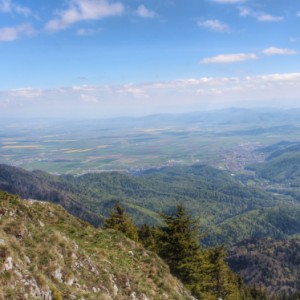Bran Castle
Sunday
Today was Orthodox Easter Sunday, and our hostess had prepared several traditional Easter foods, hard-boiled eggs, dyed different colours, an Easter bread, and a sort of meat loaf made with lamb. She explained that the tradition with the eggs is to bang the ends together with another family member, and the one will say "Christ is risen", and the other will reply "He is risen indeed"!
After breakfast, we drove to Poiana Brasov, up in the mountains, which in winter months is a ski resort, in fact Laura had been there with a school party earlier in the year. We took the cable car up to the top, for some wonderful views - see extra. Then we continued on to Bran castle. Commonly referred to as Dracula's castle, Bran Castle in fact has only tenuous links to Bram Stoker's Dracula story. It is possibly the castle he used as a setting for the story, though he had never visited Romania, so would only be going by pictures. The historical figure who provided inspiration for the story, was a character called Vlad Tepes, also known as Vlad the Impaler (1431-1476), a ruler revered by Romanians for standing up to the Ottoman Empire. He also went by his father’s name, Dracul “The Devil”. Hence, Dracula is derived from the Romanian word for devil or dragon.Bran was certainly not his castle, though it's possible he spent a couple of nights there. Known as one of the most dreadful enemies of the Turks, Vlad started organizing the state and enforcing the law by applying death penalty and impaling all those he considered enemies: robbers, cunning priests, treacherous noblemen, beggars, usurper Saxons. I personally found the castle a bit of a let down, and the village around it too tacky and commercialized.


Comments
Sign in or get an account to comment.


